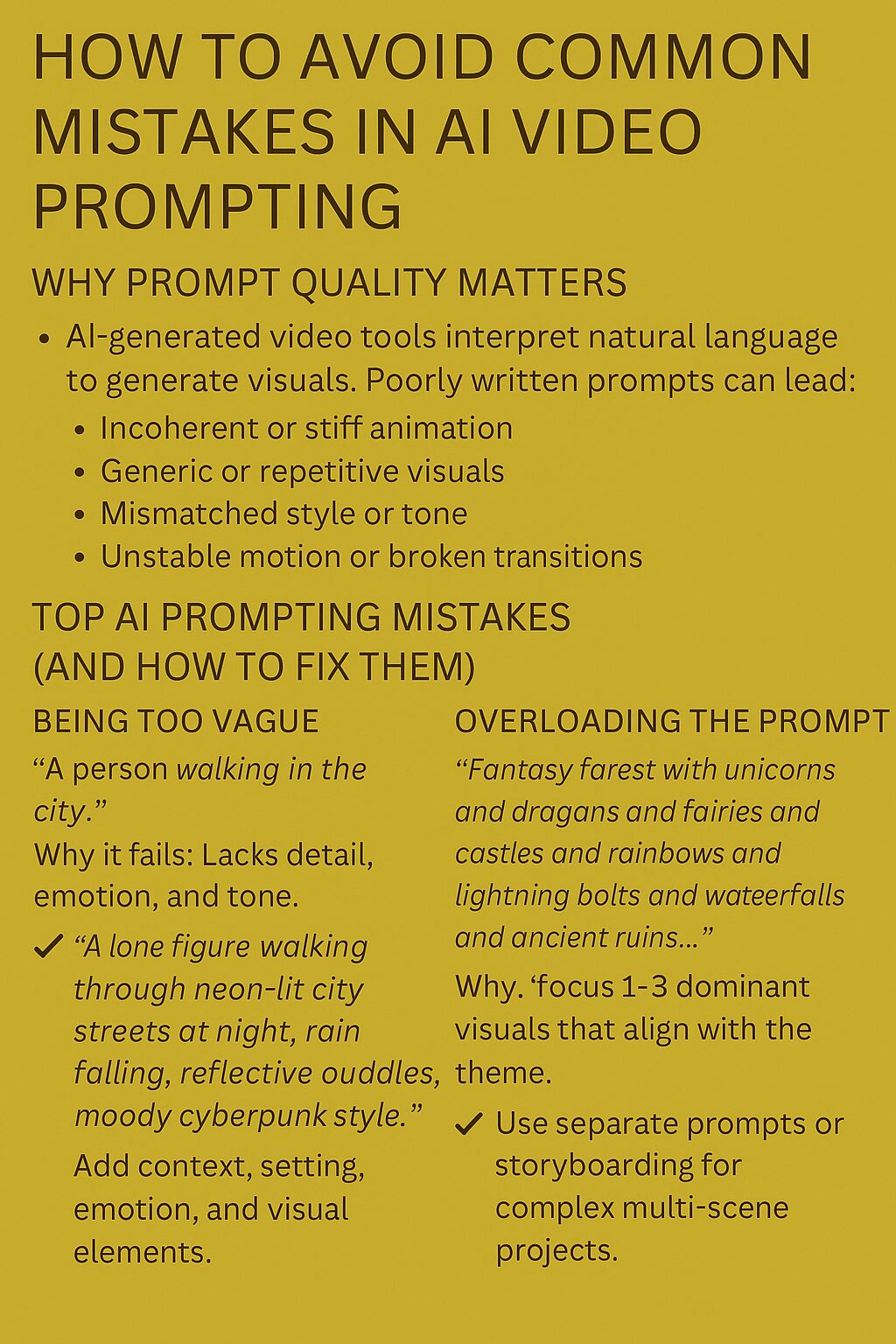Introduction
As AI video generators become more accessible, creators are crafting cinematic clips, animated loops, and short films using nothing but text. However, even the most powerful tools—like Runway ML, Pika Labs, and Kaiber—depend on well-structured prompts to produce impressive results.
In this guide, we’ll highlight the most common mistakes creators make when prompting AI for video, and share actionable strategies to write smarter, more effective prompts that rank and resonate.
🧠 Why Prompt Quality Matters
AI-generated video tools interpret natural language to generate visuals. Poorly written prompts can lead to:
- Incoherent or stiff animation
- Generic or repetitive visuals
- Mismatched style or tone
- Unstable motion or broken transitions
Avoiding common pitfalls helps you unlock smoother, more cinematic results.
🚫 Top AI Prompting Mistakes (And How to Fix Them)
1. Being Too Vague
Mistake: > “A person walking in the city.”
Why it fails: Lacks detail, emotion, and tone.
Fix: > “A lone figure walking through neon-lit city streets at night, rain falling, reflective puddles, moody cyberpunk style.”
✅ Add context, setting, emotion, and visual elements.
2. Overloading the Prompt
Mistake: > “Fantasy forest with unicorns and dragons and fairies and castles and rainbows and lightning bolts and waterfalls and ancient ruins…”
Why it fails: Confuses the AI with too many elements, leading to visual clutter.
Fix: Focus on 1–3 dominant visuals that align with the theme.
✅ Use separate prompts or storyboarding for complex multi-scene projects.
3. Skipping Motion Cues
Mistake: > “A spaceship in space.”
Why it fails: Lacks animation direction.
Fix: > “A spaceship slowly rotating above a distant planet, stars twinkling in the background, slow zoom-in camera motion.”
✅ Include verbs like floating, spinning, rising, drifting to guide animation.
4. Ignoring Camera or Style Choices
Mistake: > “Alien planet scene.”
Why it fails: Flat output without cinematic context.
Fix: > “Wide-angle shot of glowing alien planet with three moons, ambient fog, soft lens flare, sci-fi matte painting style.”
✅ Mention lens type, lighting, cinematic effect, or animation style.
5. Using Contradictory Language
Mistake: > “A high-energy sad landscape in monochrome rainbow colors with realistic surreal glitch motion.”
Why it fails: Contradicts tone, palette, and motion—AI doesn’t know what to prioritize.
Fix: Choose one aesthetic or blend styles with clear transitions.
✨ SEO Tips for Prompt-Based Video Content
To improve discoverability across platforms:
✅ Use Long-Tail Keywords in Titles
- “How to Fix Common AI Prompting Mistakes for Cinematic Video”
- “Prompting Errors to Avoid in AI-Generated Motion Art”
✅ Incorporate Structured Metadata and Tags
- #AIPromptingTips #RunwayML #AIShortFilms #PromptToVideo
✅ Add Descriptive Alt Text
- “AI video of futuristic robot walking through glitchy tunnel with neon lights”
🎬 Final Thoughts
Writing for AI isn’t just about description—it’s about direction. By avoiding common pitfalls and learning how to sculpt language like a filmmaker, you’ll get smoother motion, better visuals, and richer storytelling from your prompts.

